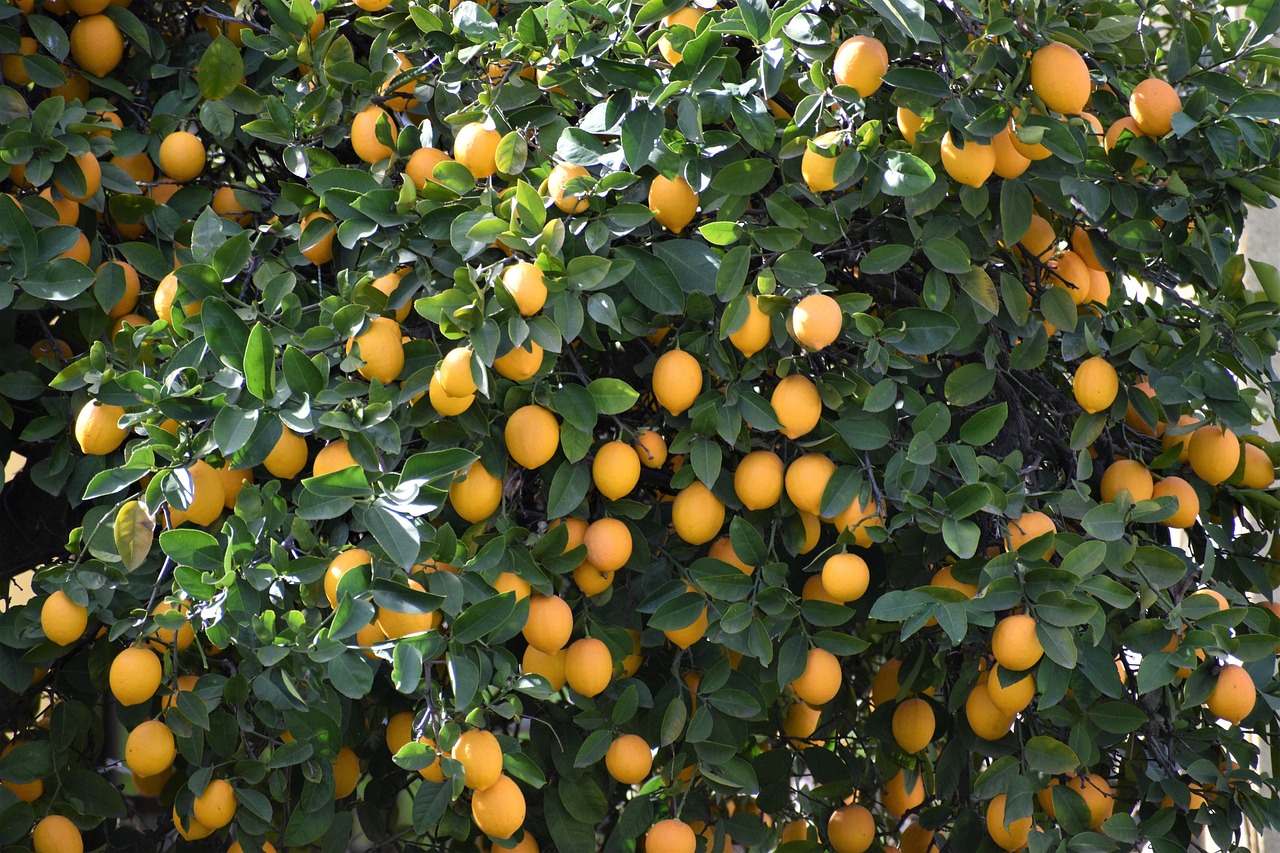Pruning lemon trees is essential for maximizing citrus production. By removing dead or overgrown branches, you enhance air circulation and sunlight exposure. This practice encourages healthier growth, increases fruit yield, and maintains the tree’s overall shape.
Lemon trees are a popular choice for home gardeners due to their fragrant blossoms and delicious fruit. Pruning is a crucial aspect of lemon tree care that can significantly impact their productivity. Understanding the proper techniques and timing for pruning can lead to a bountiful harvest. Not only does pruning promote growth, but it also helps prevent disease by ensuring that air circulates freely through the tree.

When considering pruning, it is essential to recognize the different types of pruning techniques. Each method serves a specific purpose, whether it is for shaping the tree, removing dead or diseased wood, or promoting new growth. Familiarizing yourself with these techniques will empower you to make informed decisions about how and when to prune your lemon trees.
Understanding Lemon Tree Growth
Lemon trees thrive in warm climates and require specific conditions to reach their full potential. These trees can grow quite large if left unpruned, often reaching heights of 10 to 20 feet. However, regular pruning keeps them manageable and encourages better fruit production. Here are some key facts about lemon tree growth:
| Growth Stage | Characteristics |
|---|---|
| Seedling | Young plants that require careful watering and sunlight. |
| Juvenile | Rapid growth phase; trees begin developing branches. |
| Mature | Established trees produce fruit; regular pruning necessary. |
| Old | Slower growth; may require rejuvenation pruning. |
The growth stages of lemon trees highlight the importance of timely pruning. Each stage requires different care and attention to ensure healthy development. Young trees benefit from formative pruning to shape their structure, while mature trees need maintenance to keep them productive.

In addition to understanding growth stages, recognizing the signs that indicate a need for pruning is vital. Look for branches that appear dead or diseased, as well as overcrowded areas where sunlight cannot penetrate. These conditions can hinder fruit production and may lead to pest infestations.
Optimal Pruning Techniques
There are several techniques for pruning lemon trees effectively. Each method has its advantages and can be used depending on the specific needs of the tree. Below are some common pruning techniques:
- Thinning: This technique involves removing entire branches back to their base. Thinning improves air circulation and light penetration.
- Heading: In this method, you cut back the tips of branches. This promotes bushier growth and can help control the size of the tree.
- Renewal Pruning: For older trees that have become unproductive, renewal pruning involves cutting back major branches to encourage new growth.
Applying these techniques correctly will make a significant difference in the health and productivity of your lemon tree. It is advisable to use sharp, clean tools to make precise cuts and reduce the risk of infection.

When to Prune Lemon Trees
The timing of pruning is just as important as the techniques used. Typically, the best time to prune lemon trees is during their dormant season, which is late winter or early spring before new growth begins. Pruning during this time minimizes stress on the tree and allows it to recover quickly as it enters its active growth phase.
However, some light pruning can be done throughout the year as needed. For instance, removing dead or damaged branches can be done at any time to maintain tree health. It is essential to avoid heavy pruning in late summer or fall, as this can lead to new growth that may not harden off before winter.
Monitoring weather conditions is also crucial when deciding when to prune. Avoid pruning during extreme heat or cold, as these conditions can stress the tree further and hinder recovery.

In summary, understanding how to prune lemon trees effectively involves knowing their growth stages, applying appropriate techniques, and timing your efforts correctly. With proper care, your lemon trees will reward you with abundant fruit production for years to come.
Tools and Equipment for Pruning Lemon Trees
Having the right tools is essential for effective pruning. Using proper equipment ensures clean cuts and reduces the risk of damaging your lemon trees. Here are some important tools to consider:
- Pruning Shears: These are ideal for cutting smaller branches. Look for sharp, bypass shears that create clean cuts.
- Loppers: For thicker branches, loppers provide the necessary leverage. They can cut branches up to two inches in diameter.
- Saws: A handsaw or a pole saw will be necessary for larger limbs. Ensure the blade is sharp to make clean cuts.
- Gloves: Wearing gardening gloves protects your hands from thorns and cuts.
- Safety Goggles: Protect your eyes from flying debris while pruning.
Before pruning, it is also wise to clean your tools with rubbing alcohol or a bleach solution. This practice helps prevent the spread of disease between trees, keeping your lemon trees healthy.
Identifying Branches to Prune
Knowing which branches to prune is critical for the health of your lemon tree. Here are some guidelines to help you identify branches that should be removed:
- Dead or Diseased Branches: These should be removed immediately to prevent the spread of disease.
- Crossing Branches: Branches that rub against each other can create wounds. Remove one of these branches to avoid damage.
- Weak or Spindly Growth: Thin, weak branches may not support fruit well and can be pruned back.
- Overcrowded Areas: If branches are too close together, it’s essential to thin them out to allow sunlight and air to penetrate.
By focusing on these types of branches, you can enhance the overall health and productivity of your lemon tree. Ensuring that the tree has ample space between branches promotes even growth and fruit development.
The Pruning Process
The actual process of pruning requires careful attention to detail. Follow these steps to effectively prune your lemon tree:
- Assess the Tree: Before you begin, take a moment to evaluate the overall shape and health of the tree. Identify areas that need attention.
- Remove Dead Wood: Start by cutting out any dead or diseased branches at their base, cutting just above the branch collar, which is the swollen area where a branch meets the trunk.
- Thin Out Overcrowded Growth: Selectively remove branches that are too close together. Aim for a balanced shape.
- Shape the Tree: Use heading cuts on long branches to encourage bushier growth. Focus on maintaining an open center for sunlight exposure.
- Inspect and Clean Up: After pruning, inspect the tree for any remaining unhealthy wood. Clean up fallen branches and debris from around the base of the tree.
Completing these steps will help ensure that your lemon tree grows strong and produces an abundant harvest. Each cut should be made with purpose, taking into account how it will affect the overall shape and health of the tree.
Post-Pruning Care
After pruning, providing proper care is essential for helping your lemon tree recover and thrive. Here are some key aspects of post-pruning care:
- Watering: Ensure that the tree receives adequate water after pruning, especially during dry spells. This helps support new growth.
- Fertilization: Consider applying a balanced fertilizer about a month after pruning. This will provide nutrients necessary for new growth.
- Pest Monitoring: After pruning, keep an eye out for pests or diseases. Regular inspection will help you catch issues early.
- Mulching: Apply mulch around the base of the tree to retain moisture and suppress weeds. Keep mulch a few inches away from the trunk.
Caring for your lemon tree after pruning helps it recover quickly and encourages new growth. By following these practices, you can create an ideal environment for your tree to flourish.
Common Mistakes to Avoid When Pruning
Pruining can be challenging, especially for beginners. Being aware of common mistakes can help you avoid setbacks in your lemon tree care:
- Poor Timing: Pruning at the wrong time can stress the tree and reduce fruit production. Stick to late winter or early spring.
- Over-Pruning: Removing too many branches can shock the tree and lead to reduced growth or fruiting.
- Neglecting Tool Maintenance: Using dull or dirty tools can cause injuries to the tree and spread diseases.
- Lack of Planning: Failing to assess the tree before cutting can lead to uneven shapes or excessive removal of healthy wood.
Avoiding these common mistakes will help you maintain a healthy lemon tree that produces an abundance of fruit. By being mindful during the pruning process, you can enhance your gardening success.
Understanding Lemon Tree Varieties
Different varieties of lemon trees may have varying needs when it comes to care and pruning. Knowing which variety you have can influence your pruning techniques and timing. Some of the most common lemon tree varieties include:
- Eureka: This is one of the most popular commercial varieties. It produces fruit year-round and benefits from regular pruning to maintain size and shape.
- Lisbon: Similar to Eureka, Lisbon lemons are known for their high juice content. They also require maintenance pruning to ensure fruit production.
- Meyer: This smaller, sweeter lemon tree is more tolerant of cold. Pruning should focus on shaping and removing any dead wood to promote healthy growth.
- Ponderosa: A hybrid between a lemon and a citron, this variety produces large fruit. It requires careful pruning to manage its size and enhance fruit quality.
Knowing the specific characteristics of your lemon tree variety can help you tailor your pruning strategy for maximum effectiveness. Each type may have unique growth patterns and fruiting habits that impact how you approach pruning.
Seasonal Care for Lemon Trees
In addition to annual pruning, lemon trees require ongoing seasonal care to thrive. Understanding the needs of your tree throughout the year will help you support its health and productivity. Here’s a breakdown of essential care practices by season:
Spring
Spring is an active growth period for lemon trees. During this time, focus on:
- Fertilization: Apply a balanced fertilizer to promote strong growth.
- Pest Control: Inspect for pests such as aphids or spider mites, and take action if necessary.
- Watering: Ensure consistent moisture as the tree begins its growing season.
Summer
As temperatures rise, lemon trees need special attention:
- Irrigation: Water deeply and regularly, especially if rainfall is limited.
- Mulching: Add mulch around the base to retain moisture and suppress weeds.
- Pest Monitoring: Continue monitoring for pests, as they can become more prevalent in warm weather.
Fall
As the growing season winds down, your focus should shift to preparing the tree for winter:
- Final Pruning: Conduct any necessary light pruning before the dormant season.
- Soil Care: Test soil pH and nutrient levels; amend as needed for optimal health.
- Watering Adjustments: Reduce watering as temperatures begin to drop.
winter
Winter is a critical time for lemon trees, especially in colder regions:
- Protection from Cold: If necessary, provide protection from frost by wrapping the tree or using frost cloths.
- Avoid Pruning: Refrain from heavy pruning during winter to minimize stress.
- Check for Pests: Inspect for any signs of overwintering pests that may need control.
This seasonal care routine helps ensure that your lemon tree remains healthy throughout the year. It allows you to adapt to changing conditions and support optimal growth and fruit production.
Nurturing Young Lemon Trees
If you’re starting with young lemon trees, special care is required during their formative years. Proper training and care will establish a strong foundation for future growth. Here are some tips for nurturing young lemon trees:
- Formative Pruning: In the first few years, establish a central leader by selectively pruning lower branches. This encourages upward growth and a strong structure.
- Avoid Heavy Pruning: Limit heavy pruning until the tree is well-established. Focus on shaping rather than removing significant branches.
- Fertilization Schedule: Use a slow-release fertilizer designed for citrus trees two to three times per year to support healthy growth.
- Pest and Disease Monitoring: Young trees are susceptible to pests; monitor regularly and address any issues promptly.
Caring for young lemon trees with these practices will help them develop into productive adults. Establishing good habits early on sets the stage for a fruitful future.
The Impact of Environmental Factors
The environment plays a significant role in the health and productivity of lemon trees. Here are some environmental factors to consider when caring for your trees:
- Sunlight: Lemon trees require full sun (at least 6-8 hours daily) for optimal growth and fruit production. Ensure they are planted in a location with ample light.
- Soil Quality: Well-draining soil is essential. Consider testing your soil’s pH level, as lemon trees thrive in slightly acidic conditions (around pH 6-7).
- Temperature: Lemon trees prefer warm temperatures. Protect them from extreme cold or heat by providing shade or shelter as needed.
- Humidity: Lemon trees thrive in moderate humidity levels. If you live in a dry area, consider misting the leaves or using a humidifier in nearby spaces during dry spells.
By being aware of these environmental factors, you can create the best possible conditions for your lemon trees, enhancing their ability to produce healthy fruit. Understanding how different elements affect growth will help you be proactive in your care routine.
Advanced Techniques for Pruning Lemon Trees
As you become more experienced in caring for lemon trees, you may want to explore advanced pruning techniques that can further enhance tree health and fruit production. Here are some methods to consider:
- Espalier: This technique involves training the tree to grow flat against a wall or trellis. Espaliering not only saves space but also increases sun exposure and air circulation.
- Rejuvenation Pruning: For older, unproductive trees, rejuvenation pruning can revitalize growth. This involves cutting back major branches significantly to encourage new growth.
- Crown Thinning: Selectively removing branches from the upper canopy can improve light penetration and air flow throughout the tree, promoting healthier fruit development.
Implementing these advanced techniques requires an understanding of your tree’s specific needs and growth patterns. By applying these methods thoughtfully, you can enhance the overall structure and productivity of your lemon trees.
Integrating Organic Practices
More gardeners are turning to organic practices when caring for their lemon trees. These methods are not only beneficial for the environment but can also improve the quality of your fruit. Some organic practices include:
- Composting: Create your own compost using kitchen scraps and yard waste. Applying compost improves soil health and provides essential nutrients to your lemon trees.
- Natural Pest Control: Use beneficial insects like ladybugs or predatory wasps to control pest populations. In addition, neem oil can be an effective organic pesticide.
- Mulching with Organic Materials: Use organic mulch such as straw or wood chips around the base of the tree. This helps retain moisture and suppress weeds naturally.
By integrating organic practices into your care routine, you can maintain a healthy ecosystem in your garden while producing delicious, chemical-free lemons.
Common Pests and Diseases
Being aware of common pests and diseases that affect lemon trees is critical for effective management. Early detection and treatment can prevent significant damage. Here are some of the most common issues:
Pests
- Aphids: These small insects suck sap from leaves, causing them to curl and yellow. Treat with insecticidal soap or introduce ladybugs.
- Scale Insects: Scale appears as small, brownish bumps on branches and leaves. They can be removed by hand or treated with horticultural oil.
- Spider Mites: These tiny pests thrive in dry conditions and can cause leaf discoloration. Increase humidity and use miticide if necessary.
Diseases
- Citrus Canker: This bacterial disease results in lesions on leaves and fruit. Remove affected areas and ensure proper spacing for air circulation.
- Root Rot: Caused by overwatering, it leads to yellowing leaves and stunted growth. Ensure well-draining soil and avoid waterlogged conditions.
- Powdery Mildew: This fungal disease appears as a white powder on leaves. Improve air circulation and use fungicides if necessary.
Regular monitoring for pests and diseases, combined with prompt action, will help keep your lemon trees healthy and productive.
Importance of Patience and Observation
Caring for lemon trees is a long-term commitment that requires patience. Unlike annual crops, citrus trees take time to establish themselves and begin producing fruit. Regular observation is key to understanding your tree’s needs. Take note of growth patterns, fruit set, and any changes in leaf color or texture.
Keeping a gardening journal can be beneficial. Document your observations regarding pruning dates, fertilization schedules, pest sightings, and weather conditions. This information will help you refine your care techniques over time and adapt to changing circumstances.
Conclusion
Pruning lemon trees is a vital practice for maximizing citrus production. By understanding the growth stages, employing proper techniques, and providing seasonal care, you can ensure that your lemon trees thrive. Awareness of environmental conditions, pest management, and the use of organic practices contribute to a healthy growing environment.
The journey of nurturing lemon trees is rewarding, requiring commitment and attention to detail. With patience and care, you will enjoy bountiful harvests of fresh lemons that enhance your culinary creations and bring joy to your garden.
By implementing the strategies discussed in this article, you are well on your way to becoming a proficient lemon tree caretaker. Embrace the learning process, experiment with different techniques, and watch your lemon trees flourish!
